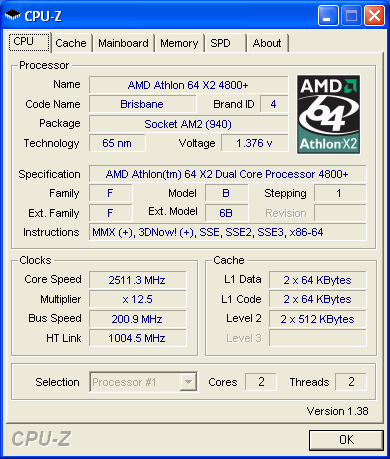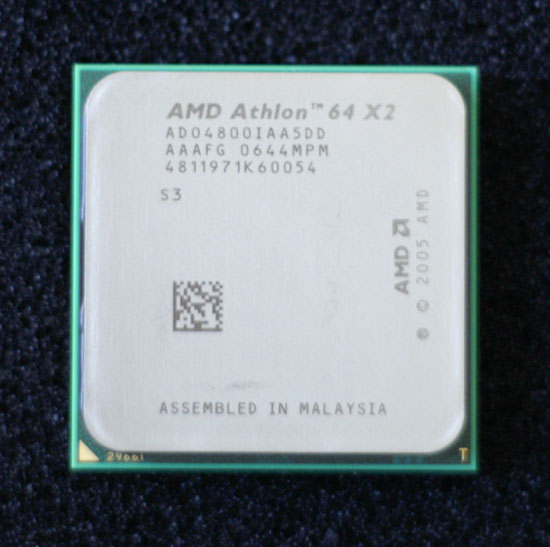AMD's 65nm Preview Part 2 - The Plot Thickens (Updated with Information from AMD)
by Anand Lal Shimpi on December 21, 2006 12:12 AM EST- Posted in
- CPUs
Updated: Page 3 has been updated to include an official AMD response on the Brisbane performance issues we've been seeing. AMD confirmed an increase in L2 cache latency in order to support a move to larger cache sizes in the future, which may or may not happen. The rest of the article remains unchanged.
Last week AMD sent us samples of its first 65nm processors, codenamed Brisbane, and it was a step towards being competitive with Intel again. The 65nm shrink yielded AMD's most efficient desktop processor to date, but it's still a far cry away from what Intel is able to accomplish with its Core 2 processors.
Although they won't be available until sometime next year, a closer look at AMD's 65nm lineup reveals an interesting fact. Until recently, AMD would differentiate between subsequent model numbers by clock speed and cache size, alternating between the two. So while the Athlon 64 X2 4600+ and 4800+ both ran at 2.4GHz, the latter had twice the L2 cache per core at 1MB. After Intel's Core 2 launch, AMD killed all non-FX 1MB L2 parts, resulting in a processor lineup that was mostly segregated according to clock speed. (Of course they then added the X2 5200+ and 5600+ back into the mix....) With the move to 65nm, AMD is once again introducing model numbers that it had killed off before, but without playing with L2 cache sizes; instead, AMD is breaking with recent tradition and implementing non-integer clock multipliers for these "new" in-between speeds. The table below explains it all:
| CPU | Clock Multiplier | Clock Speed |
| AMD Athlon 64 X2 5000+ EE | 13.0x | 2.6GHz |
| AMD Athlon 64 X2 4800+ EE | 12.5x | 2.5GHz |
| AMD Athlon 64 X2 4600+ EE | 12.0x | 2.4GHz |
| AMD Athlon 64 4400+ EE | 11.5x | 2.3GHz |
| AMD Athlon 64 X2 4000+ EE | 10.5x | 2.1GHz |
We didn't mention this in the original article, but all of AMD's 65nm CPUs are considered to be Energy Efficient (denoted by the letters EE in the table above). With its 90nm chips, AMD specifically selected lower voltage parts to be labeled as Energy Efficient, but right now all 65nm parts are. For the sake of simplicity, especially as we compare to older EE parts, we will simply refer to these chips as 65nm chips.
Note that the 65nm 4800+, 4400+ and 4000+ all use non-integer clock multipliers, a first for the Athlon 64 line. The implications for the end user are relatively minor, although it does mean that the model numbers will translate into more consistent performance graduations. In the past, having two chips running at the same clock speed but with different cache sizes meant that one would be faster only in those applications that could use the extra cache.

Despite support for non-integer clock multipliers, all AMD chips still only support integer memory dividers, meaning that only CPUs with even CPU multipliers can run at DDR2-800. All odd clocked (5000+) and half-clocked processors (4800+, 4400+, 4000+) run at a slower than DDR2-800 speed, even when set to DDR2-800 in the BIOS. AMD wouldn't discuss whether or not this would be addressed in the future, but if it is we'd have to wait for at least another silicon revision.

By now, none of this is new information, which brings us to why we're here today. In our original 65nm article we noticed a performance disparity between AMD's 65nm and 90nm processors, yet we had no official response from AMD as to why; today we have that answer. At the same time, we wanted to take a look at one of the half-multiplier chips and add it to our performance and power graphs, not to mention include some lower cost Intel CPUs per your requests. We've also got some more insight into the die sizes and power consumption figures we reported in our last article. In a sense, we're tying up loose ends with this piece, and shedding more light on AMD's 65nm cores than we originally did in our first, quick preview.










52 Comments
View All Comments
Spoelie - Thursday, December 21, 2006 - link
This is not the first time this has happened, it may be easy to forget, but do you guys remember the thoroughbred?Thoroughbred A was the first 180nm to 130nm shrink and had a hard time reaching the speeds the mature 180nm cores were getting. It wasn't till AMD added another layer to the core (Thoroughbred B) that we saw the expected speedups from a die shrink.
PetNorth - Thursday, December 21, 2006 - link
Anand:Why don't you set manually the voltage, to know really what's the improvement with 0.65 transition?
1.30v to compare it with 5000+ 90nm, and 1.25v to compare it with 4600+ EE 0.90nm.
It would be a good thing IMO.
yyrkoon - Thursday, December 21, 2006 - link
There are already people who believe that odd numbered multipliers offer worse performance compared to even numbered multipliers. I cant help but wonder why AMD chose to start implementing floating point multipliers now. The first thing that comes to mind, is maybe to refine their pricing ? Although, I've never really noticed much performance (if any) difference using odd vs even numbered multipliers, I can not help but wonder if floating point multipliers will play a factor in performance.Regs - Thursday, December 21, 2006 - link
AMD has been stepping in baby steps in their innovation merits. Ever since the IMC and the enhancements from K7 to K8 it seems like they improve little by little. I hope this gives them a rude awakening to how competitive the market can or could be in future. If they did it before they can do it again.As for the transition to 65nm, it was no surprise that these parts could not over clock very well. The K8 is showing its age and I think there are no more ways you can breathe life back into it especially when Core Duo is out in the market.
mino - Thursday, December 21, 2006 - link
Why awekening, and why rude? The fact is AMD kept PARITY with intel on power AND performance inthe lower end with 90nm!!! part with Intel beeing at 65nm for a year allredy!In other words, When AMD's 90nm process is FAR better that Intel's ever was. Same happened with 130nm. Two words: SOI,APM.
No confusion, all thi means no one should avaluate AMD vs. Intel on process_used base. Simply put, as of now(at stock) Intel rules on perf&power while AMD rules on idle_power and price(up to 4200+/E6300 combo).
IntelUser2000 - Thursday, December 21, 2006 - link
Intel bins Core 2 Duo by power consumption.
xsilver - Thursday, December 21, 2006 - link
just to clarify further; all e6600's will have lower stock voltages than e6400's and all e6400's will have lower stock voltages than e6300's?at both idle and load?
how successful are the conroes at undervolting?
Accord99 - Thursday, December 21, 2006 - link
Pretty good, my week 25 E6600 is stable at 2.6GHz/1.1v (My P5B-dlx doesn't go any lower) with dual-P95. The heat output is easily cooled passively by a Scythe Ninja.Here's a thread, one person has a E6600 that does 2.4@/~1v
http://www.xtremesystems.org/forums/showthread.php...">http://www.xtremesystems.org/forums/showthread.php...
blackbrrd - Thursday, December 21, 2006 - link
I have seen a E6600 running at 1,0v at load... It was obviously very cool running :)My E6400 is running at 1,15v at idle (2133MHz) and 1,25v at load (2133MHz)
Power saving features were off in both instances...
haugland - Thursday, December 21, 2006 - link
AMD win in one aspect...I you really consider power consumption to be important, it is much more important to look at idle power consumption than power consumption at full load. Most business PCs idle a lot of the time, and AMDs CPUs are much better at saving power at idle.
EIST was designed for P4, and for a 3+ GHz P4 it makes sense to drop the multiplier to 6. However when the E6300 normally run at a multiplier of 7, you don't get much of a power saving by dropping the multiplier to 6. AMD C'n'Q allows for much lower settings.